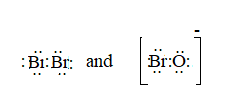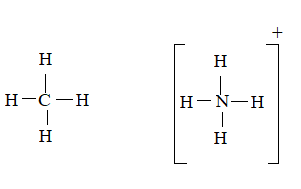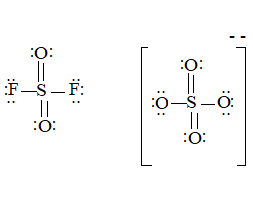
Concept explainers
(a)
Interpretation:
The formula of the polyatomic ion needs to be determined having similar Lewis structure as the
Concept introduction:
The Lewis structures are used to write a shorthand configuration of number of available valence electrons in an atom for bonding. This structure deals with the magic number 8, and hence, the octet completion is shown by the bonded electrons between the atoms.
This structure is made on basis of octet rule understanding, and it is made sure that the number of electrons surrounding an atom must not divert from the octet.
Answer to Problem 16QAP
Explanation of Solution
Given Information:
The ion is BrO-.
Here, the total valence electrons are:
Bond pair electrons are obtained as:
Similarly, lone pairs are counted as:
A similar type of Lewis structure is possible in only such molecule, which has nearly matching electronegativities and same number of valence electrons.
In this pattern, the bromine molecule
Here, the valence electrons are:
Bond pair electrons are obtained as:
Similarly, lone pairs are counted as:
The Lewis structure will be drawn as:

(b)
Interpretation:
The formula of the polyatomic ion needs to be determined having similar Lewis structure as the
Concept introduction:
The Lewis structures are used to write a shorthand configuration of number of available valence electrons in an atom for bonding. This structure deals with the magic number 8, and hence, the octet completion is shown by the bonded electrons between the atoms.
This structure is made on basis of octet rule understanding, and it is made sure that the number of electrons surrounding an atom must not divert from the octet.
Answer to Problem 16QAP
CH4 molecule
Explanation of Solution
Given Information:
The ion is
Here the total valence electrons are:
Bond pair electrons are obtained as:
Similarly, lone pairs are counted as:
A similar type of Lewis structure is possible in only such molecule, which has nearly matching electro negativities and same number of valance electrons.
In this pattern, the methane molecule
Here the valence electrons are:
Bond pair electrons are obtained as:
Similarly, lone pairs are counted as:
The Lewis structure will be drawn as:

(c)
Interpretation:
The formula of the polyatomic ion needs to be determined having similar Lewis structure as the
Concept introduction:
The Lewis structures are used to write a shorthand configuration of number of available valence electrons in an atom for bonding. This structure deals with the magic number 8, and hence, the octet completion is shown by the bonded electrons between the atoms.
This structure is made on basis of octet rule understanding, and it is made sure that the number of electrons surrounding an atom must not divert from the octet.
Answer to Problem 16QAP
CO molecule.
Explanation of Solution
Given Information:
The ion is
Here the total valence electrons are:
Bond pair electrons are obtained as:
Similarly, lone pairs are counted as:
A similar type of Lewis structure is possible in only such molecule which has nearly matching electronegativities and same number of valence electrons.
In this pattern, the carbon monoxide (CO) is best suitable as:
Here, the valence electrons are:
Bond pair electrons are obtained as:
Similarly, lone pairs are counted as:
The Lewis structure will be drawn as:

(d)
Interpretation:
The formula of the polyatomic ion needs to be determined having similar Lewis structure as the
Concept introduction:
The Lewis structures are used to write a shorthand configuration of number of available valence electrons in an atom for bonding. This structure deals with the magic number 8, and hence, the octet completion is shown by the bonded electrons between the atoms.
This structure is made on basis of octet rule understanding, and it is made sure that the number of electrons surrounding an atom must not divert from the octet.
Answer to Problem 16QAP
Explanation of Solution
Given Information:
The ion is
Here the total valence electrons are:
Bond pair electrons are obtained as:
Similarly, lone pairs are counted as:
A similar type of Lewis structure is possible in only such molecule which has nearly matching structure.
Now, in this pattern, the anion
Here the valence electrons are:
Looking at the structure,
Bond pair electrons are obtained as:
Similarly, lone pairs are counted as:
The Lewis structure will be drawn as:

Want to see more full solutions like this?
Chapter 7 Solutions
EBK CHEMISTRY: PRINCIPLES AND REACTIONS
- Understanding the general acid-base properties of amino acids O Proteins Imagine each of the molecules shown below was found in an aqueous solution. Can you tell whether the solution is acidic, basic, or neutral? molecule The solution is... 010 H3N-CH-C-OH CH HO CH3 O acidic O basic neutral O (unknown) H3N HO 0 O acidic O basic neutral ○ (unknown) H3N-CH-C-O CH2 CH3-CH-CH3 O acidic O basic Oneutral ○ (unknown) O= X H2N-CH-C-O CH3 CH CH3 acidic O basic O neutral ○ (unknown) ? 000arrow_forwardImagine each of the molecules shown below was found in an aqueous solution. Can you tell whether the solution is acidic, basic, or neutral? molecule 0=0 H3N-CH-C-o HO CH2 OH The solution is... O acidic O basic O neutral O (unknown) H₂N acidic O basic O neutral ○ (unknown) + H3N O OH O acidic O basic O neutral O (unknown) H2N-CH-C-O CH3 O acidic O basic neutral ○ (unknown) X ? olo HEarrow_forwardRecognizing ampli Draw an a amino acid with a methyl (-CH3) side chain. Explanation Check Click and drag to start drawing a structure. X Carrow_forward
- Write the systematic name of each organic molecule: structure name × HO OH ☐ OH CI CI O CI OH OHarrow_forwardく Check the box under each a amino acid. If there are no a amino acids at all, check the "none of them" box under the table. Note for advanced students: don't assume every amino acid shown must be found in nature. COO H3N-C-H CH2 HO CH3 NH3 O CH3-CH CH2 OH Onone of them Explanation Check + H3N O 0. O OH + NH3 CH2 CH3-CH H2N C-COOH H O HIC + C=O H3N-C-O CH3- - CH CH2 OH Х 2025 McGraw Hill LLC. All Rights Reserved. Terms of Use | Privacy Center Accesarrow_forwardWrite the systematic name of each organic molecule: structure HO-C-CH2-CH3 O -OH CH3-CH2-CH2-CH2-CH2-C-OH CH3 CH3-CH-CH2-C-OH Explanation Check S namearrow_forward
- theres 2 productsarrow_forwardDraw the major product of this solvolysis reaction. Ignore any inorganic byproducts. + CH3CH2OH Drawing Q Atoms, Bonds and Rings OCH2CH3 || OEt Charges OH 00-> | Undo Reset | Br Remove Done Drag To Pan +arrow_forwardDraw the major product of this SN1 reaction. Ignore any inorganic byproducts. CH3CO2Na CH3CO2H Drawing + Br Q Atoms, Bonds and Rings OAC Charges OH ОАс Na ဂ Br Undo Reset Remove Done Drag To Pan +arrow_forward
- Organic Functional Groups entifying positions labeled with Greek letters in acids and derivatives 1/5 ssible, replace an H atom on the a carbon of the molecule in the drawing area with a ce an H atom on the ẞ carbon with a hydroxyl group substituent. ne of the substituents can't be added for any reason, just don't add it. If neither substi er the drawing area. O H OH Oneither substituent can be added. Check D 1 Accessibility ado na witharrow_forwardDifferentiate between electrophilic and nucleophilic groups. Give examples.arrow_forwardAn aldehyde/ketone plus an alcohol gives a hemiacetal, and an excess of alcohol gives an acetal. The reaction is an equilibrium; in aldehydes, it's shifted to the right and in ketones, to the left. Explain.arrow_forward
 Chemistry: The Molecular ScienceChemistryISBN:9781285199047Author:John W. Moore, Conrad L. StanitskiPublisher:Cengage Learning
Chemistry: The Molecular ScienceChemistryISBN:9781285199047Author:John W. Moore, Conrad L. StanitskiPublisher:Cengage Learning
